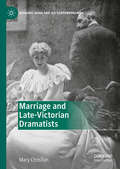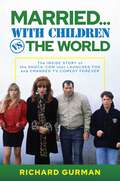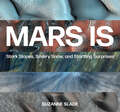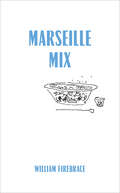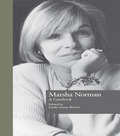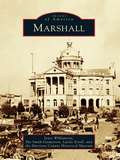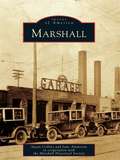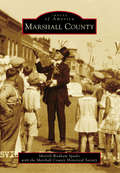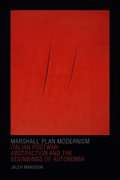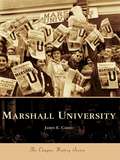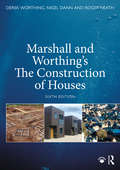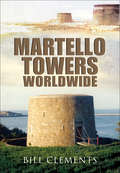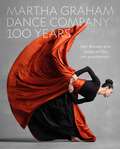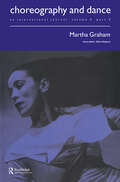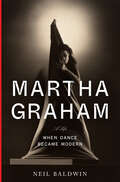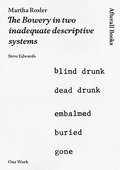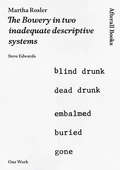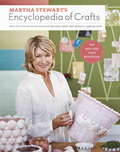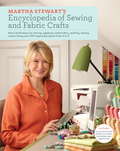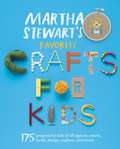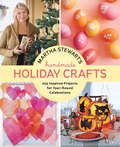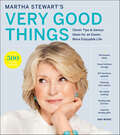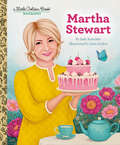- Table View
- List View
Marriage and Late-Victorian Dramatists (Bernard Shaw and His Contemporaries)
by Mary ChristianThis book examines plays produced in England in the 1890s and early 1900s and the ways in which these plays responded to changing perceptions of marriage. Bernard Shaw, Oscar Wilde, and other late-Victorian dramatists challenged romanticized ideals of love and domesticity, and, in the process, these authors appropriated and rewrote the genre conventions that had dominated English drama for much of the nineteenth century. In their plays, theater became a forum for debating the problems of traditional marriage and envisioning alternative forms of partnership. This book is written for scholars specializing in the areas of Victorian studies, dramatic literature, theater history, performance studies, and gender studies.
Married… With Children vs. the World: The Inside Story of the Shock-Com that Launched FOX and Changed TV Comedy Forever
by Richard GurmanA rollicking account of the groundbreaking show from one of the show&’s producers, featuring the voices of the stars, creators, and executives involved with bringing it to life. &“I had the pleasure of working with Richard Gurman for eleven years. When he sent me his new book Married… With Children vs. the World, I figured it would be a trip down memory lane. So I was stunned by some revelations I never knew. And reminded how brilliant much of the writing was. What a time that was. If you liked Married… With Children, then you should read this book. You&’re in for a treat!&” —Ed O&’NeillMarried… With Children burst onto the airwaves with a full-frontal attack on the myth of domestic tranquility depicted in family comedies since the dawn of TV. The outlier series, created by two rebellious writers given carte blanche from a fledgling FOX, became one of the longest running live-action sitcoms in television history and forever changed the way married life was portrayed on the very networks it so scathingly satirized. But it was far from smooth sailing as the creators bucked up against Barry Diller—then CEO of FOX—on everything from casting to content and then butted heads with network standards as they sought to shatter traditional broadcast norms. "Reading Married… With Children vs. the World jolted me right back into the mindset where our little show was the rock &’n&’ roll of sitcoms fighting to get heard in an easy-listening world. Richard Gurman, who was there for the whole ride, digs deep into the joys and frustrations of the entire experience and turns it up loud.&” —Katey Sagal Married… With Children writer-producer Richard Gurman takes us behind the scenes of this boundary-breaking show to reveal how its inner workings were at times as disruptive and contentious—yet at other times, as hysterical and raunchy—as the Bundy family themselves. Featuring exclusive interviews with the cast, including Ed O&’Neill and Katey Sagal, media moguls, network executives, writers, directors, critics, and even the woman who was so offended by one episode she launched a sponsor boycott that almost got the series canceled, Married… With Children vs. the World celebrates the rebellious, satirical vision of the show and the battle to keep it alive that paved the way for the tremendous diversity in family comedy style we see today. &“Not only is this an accurate chronicle of both families, on either side of the camera, but what should also serve as a valuable lesson of never giving up on a dream.&” —Michael G. Moye, Co-Creator &“I had almost as much fun reading Married… with Children vs. the World as I had working on the show. Almost. Richard Gurman chronicles, from his vantage point inside the writers&’ room and the sound booth, how we broke the china in the family sitcom kitchen, and upended the television industry by doing so. What could be more fun than that?&” —David Garrison
Mars Architecture: Construction 6.0 for Designing Sustainable and Health-Oriented Habitats
by Amjad Almusaed Ibrahim Yitmen Asaad AlmssadThis book combines Construction 6.0 with AEC principles for designing sustainable, health-focused Martian habitats. It unveils innovative architectural designs ideal for Mars, utilizing 3D printing, autonomous robotics, and regolith, alongside renewable energy and life support systems. With an emphasis on well-being, it integrates biophilic design and digital technologies to enhance operational efficiency. Exploring various habitat models, it advocates a multidisciplinary approach to extraterrestrial colonization that balances technological advancement with environmental and ethical stewardship, aiming to make human life on Mars a healthy and sustainable reality.
Mars Is: Stark Slopes, Silvery Snow, and Startling Surprises
by Suzanne SladeAward-winning author and former rocket engineer Suzanne Slade explores the diverse magnificence of Mars in this photo-packed extravaganza, perfect or readers eagerly following NASA's Mars Exploration Program!For centuries, people have been intrigued by Mars, and over time, scientists have made exciting discoveries, such as the planet's Earth-like weather and seasons. But curious earthlings want to know more about the Red Planet. Does Mars have deserts? Volcanos? Or signs of life? Could people live there someday?Scientists decided to take a closer look. They built a powerful camera called the HiRISE (High Resolution Imaging Science Experiment) and loaded it onto a rocket. The rocket blasted off on August 12, 2005, and seven months later, the camera began orbiting Mars. It sent back surprising, revealing photos showing the world what Mars really is. Now, the world's space community and NASA have renewed their exploration efforts, and interest in the Red Planet is in high gear.With elegant, spare prose, Suzanne Slade leads readers through some of the stunning photos taken by the most advanced camera ever sent to another planet. A visual feast for space enthusiasts and STEAM fans. Features remarkable full-color photography throughout.
Marseille Mix
by William FirebraceA journey through the history, cultures, and societies of Marseille.There are many Marseilles, or at least many versions of Marseille: seaside village, haven of gangsters, gateway to the East, city of immigrants and outcasts. It is by turns the dull bourgeois provincial town where nothing ever happens and the mysterious unknowable city of the Mediterranean. In Marseille Mix, William Firebrace explores the many Marseilles, the invented and the actual. Leading readers down narrow streets, through undulating terrain that seems at once, or serially, Italian, Greek, Levantine, and North African, Firebrace traces the history and culture of Marseille through landscapes, buildings, food, films, literature, and criminology. In seven chapters, in writing that is by turns essay, narrative, description, list, recipe, glossary, and conversation, Firebrace investigates the city&’s defining mix. He tells stories of famous Marseillais, including Marcel Pagnol and Antonin Artaud, and famous visitors, including the dying Arthur Rimbaud and Walter Benjamin (who wrote about one visit in &“Hashish in Marseille&”). He describes the brief period when Marseille was the point of departure for European refugees fleeing the Nazis and the city&’s mixture of desperation and decadence during the Vichy regime. He visits the basilica of Notre Dame de la Garde and gazes down from its terrace at the panoramic view: an agglomeration of neighborhoods and landscapes that became a city.
Marsha Norman: A Casebook (Casebooks on Modern Dramatists #Vol. 19)
by Linda Ginter BrownFirst Published in 1996. Routledge is an imprint of Taylor & Francis, an informa company.
Marshall
by Pat Smith-Gasperson Harrison County Museum Lucile Estell Joyce WilliamsonNestled among towering pine trees in East Texas is the city of Marshall. Marshall is closely identified with Caddo Lake, a massive body of water located northeast of the town. According to the Caddo Indians who first inhabited this land, the mysterious lake was formed overnight from an earthquake. Spanish and French explorers sought to claim the land as their own in the 16th century, and American settlers arrived here in about 1830. The city of Marshall was founded in 1842, eventually becoming the county seat of Harrison County. With the arrival of the Texas and Pacific Railroad after the Civil War, Marshall became known as the "Gateway to Texas," and the town prospered. Today education plays an important role in the local economy, and Marshall is the home of Wiley College, East Texas Baptist University, and Texas State Technical Institute. Life in Marshall continues to revolve around the town square, with the majestic, restored courthouse at its center.
Marshall
by Jane Ammeson Susan Collins Marshall Historical SocietyA charming Michigan town and recipient of the Dozen Distinctive Destinations award by the National Trust for Historic Preservation, Marshall boasts homes and businesses that are immaculately restored architectural gems whose styles include Gothic Revival, Queen Anne, and Second Empire. To stroll along the streets here, past the Honolulu House, home to the Marshall Historical Society and a paean to a 19th-century judge's passion for the tropics, toward the National House, an old stagecoach inn dating back to the 1840s and now a thriving bed-and-breakfast, is to appreciate the homage to the past that has kept this jewel of a town a major travel destination for those who honor history. History comes alive to those dining at Winn Schuler's, the oldest restaurant in the state and a mainstay in downtown Marshall since the beginning of the 20th century. In Marshall, it is easy to step back in time and enjoy all that life had to offer to travelers of a different era.
Marshall County
by Marshall County Historical Society Sherrill Wadham SparksThe Oregon-California Trail carried more than 100,000 settlers west over the prairies of the future state of Kansas in the mid-1800s. Pioneers and Pony Express riders crossed the Big Blue River at Independence Crossing or at Frank Marshall's ferry near present-day Marysville. In 1846, members of the Donner Party discovered and named Alcove Spring, now one of 20 county sites listed in the National Register of Historic Places. The Kansas Territorial Legislature established Marshall County in 1855. After the Civil War, rich soil and abundant water attracted farmers, and its location attracted railroads and industry. Today, the same occupations still sustain the 16 towns and villages. As the "Gateway to the Flint Hills," the county's rolling hills are dotted with picturesque prairie, woods, limestone outcrops, rivers, and creeks. Even though the county is a crossroads for modern highways US 36 and US 77, pioneer wagon ruts are still visible in Marshall County.
Marshall Plan Modernism: Italian Postwar Abstraction and the Beginnings of Autonomia
by Jaleh MansoorFocusing on artwork by Lucio Fontana, Alberto Burri, and Piero Manzoni, Jaleh Mansoor demonstrates and reveals how abstract painting, especially the monochrome, broke with fascist-associated futurism and functioned as an index of social transition in postwar Italy. Mansoor refuses to read the singularly striking formal and procedural violence of Fontana's slit canvasses, Burri's burnt and exploded plastics, and Manzoni's "achromes" as metaphors of traumatic memories of World War II. Rather, she locates the motivation for this violence in the history of the medium of painting and in the economic history of postwar Italy. Reconfiguring the relationship between politics and aesthetics, Mansoor illuminates how the monochrome's reemergence reflected Fontana, Burri, and Manzoni's aesthetic and political critique of the Marshall Plan's economic warfare and growing American hegemony. It also anticipated the struggles in Italy's factories, classrooms, and streets that gave rise to Autonomia in the 1960s. Marshall Plan Modernism refigures our understanding of modernist painting as a project about labor and the geopolitics of postwar reconstruction during the Italian Miracle.
Marshall University (Campus History)
by James E. CastoIn 1837, the people of Guyandotte, then a village on the Virginia frontier, resolved to open a school for their sons and daughters. Tradition says local lawyer John Laidley convinced his neighbors to name the school for his friend, Chief Justice John Marshall. The one-room log cabin that housed those first students soon gave way to a two-story brick building that, with various additions over the years, became the school's Old Main. For decades, the cherished landmark has stood like a proud sentinel, watching Marshall grow and evolve into a major university with an enrollment over 16,000. This remarkable volume, with more than 200 historic photographs from the Marshall archives, chronicles the dramatic Marshall saga.
Marshall and Worthing's The Construction of Houses
by Derek Worthing Duncan Marshall Roger Heath Nigel DannThe sixth edition of The Construction of Houses builds on the success of the previous five editions. The book provides a comprehensive introduction to the principles and processes of the construction of houses and their services. As such it is aimed at providing a broad understanding of domestic building construction for students as part of their academic studies and as a useful information source for practitioners. The existing chapters have all been updated and most of them expanded to take account of changes to dwelling house construction since the last edition and there are new chapters on ‘Modern Methods of Construction’ and ‘Regulatory controls and building standards’. Additionally, many new and/or updated photographs and diagrams have been added. As with the previous editions, the authors have concentrated on presenting current mainstream approaches to the construction of houses. The detailed, yet accessible, text that is supported by hundreds of coloured photographs and diagrams provides clear explanations of the many complex processes that go into the building of a house. A deeper insight into modern construction is also given by the book’s consideration of historical building techniques from the 18th century onwards in order to illustrate how and why we build houses in the way we do now.
Martello Towers Worldwide
by Bill ClementsMartello Towers Worldwide follows the history of the Martello tower from the construction of the early towers built to protect the Mediterranean shores of Spain and Italy right up to the final towers built in the United Kingdom during the First World War.The book is illustrated with a large number of contemporary and historic photographs, drawings and plans, a very large number of which were not included in the earlier Towers of Strength. These provide the most detailed information yet published about the development of the Martello towers in Britain and overseas. So the book will be of particular interest to those interested in the history of fortifications, architectural conservation and military history generally. It will also be of interest to an international readership as the book now has a gazetteer of towers outside the United Kingdom that remain today together with a chapter describing a number of towers built in the United States.The book supplements the earlier Towers of Strength and such will be an important addition to the existing bibliography of books on Martello towers and fortification.
Martha Graham Dance Company 100 Years
by Ken Browar Deborah Ory***Winner of the International Photography Award for Best Book of 2025***A stunning photographic celebration of The Martha Graham Dance Company on its 100th anniversary, from Ken Browar and Deborah Ory, the creative team behind NYC Dance Project. Founded in 1926 by Martha Graham, The Martha Graham Dance Company is the oldest dance company in the United States and remains one of the world&’s most distinguished and highly acclaimed. Graham's original works drew from a variety of influences, notably Greek mythology, the American frontier, and traditional Native American ceremonies, and were characterized by her trademark technique of "contraction and release." She is also renowned for her ongoing collaboration with several of her contemporary creative visionaries, including sculptor Isamu Noguchi, actor and director John Houseman, composer Aaron Copland, and fashion designers Halston, Donna Karen, and Calvin Klein. Martha Graham Dance Company 100 Years is a monumental photographic tribute to Graham&’s profound creative heritage. Featuring a joyous selection of twenty-four of Graham&’s most memorable works, Browar and Ory capture the beauty and the precision of dancers who make up today&’s company and who carry the mantle of Graham&’s legacy. Each featured dance is prefaced by a piece of archival imagery as well as a description of the dance and notes on costume design, set design, and accompanying music. An in-depth feature on Noguchi&’s set design as well as an introduction by Martha Graham Dance Company artistic director Janet Eilber round out the program.
Martha Graham: A Dancer's Life
by Russell FreedmanA photo biography of the American dancer, teacher, and choreographer who was born in Pittsburgh in 1895 and who became a leading figure in the world of modern dance.
Martha Graham: A special issue of the journal Choreography and Dance (Choreography And Dance Studies Ser.)
by Alice HelpernFirst Published in 1999. Routledge is an imprint of Taylor & Francis, an informa company.
Martha Graham: When Dance Became Modern
by Neil BaldwinA major biography—the first in three decades—of one of the most important artistic forces of the twentieth century, the legendary American dancer and choreographer who upended dance, propelling the art form into the modern age, and whose profound and pioneering influence is still being felt today."Brings together all the elements of Graham&’s colorful life...with wit, verve, critical discernment, and a powerful lyricism.&”—Mary Dearborn, acclaimed author of Ernest HemingwayTime magazine called her &“the Dancer of the Century.&” Her technique, used by dance companies throughout the world, became the first long-lasting alternative to the idiom of classical ballet. Her pioneering movements—powerful, dynamic, jagged, edgy, forthright—combined with her distinctive system of training, were the epitome of American modernism, performance as art. Her work continued to astonish and inspire for more than sixty years as she choreographed more than 180 works.At the heart of Graham&’s work: movement that could express inner feeling.Neil Baldwin, author of admired biographies of Man Ray (&“Truly definitive . . . absolutely fascinating&” —Patricia Bosworth) and Thomas Edison (&“Absorbing, gripping, a major contribution to our understanding of a remarkable man and a remarkable era&” —Robert Caro), gives us the artist and performer, the dance monument who led a cult of dance worshippers as well as the woman herself in all of her complexity.Here is Graham, from her nineteenth-century (born in 1894) Allegheny, Pennsylvania, childhood, to becoming the star of the Denishawn exotic ballets, and in 1926, at age thirty-two, founding her own company (now the longest-running dance company in America). Baldwin writes of how the company flourished during the artistic explosion of New York City&’s midcentury cultural scene; of Erick Hawkins, in 1936, fresh from Balanchine&’s School of American Ballet, a handsome Midwesterner fourteen years her junior, becoming Graham&’s muse, lover, and eventual spouse. Graham, inspiring the next generation of dancers, choreographers, and teachers, among them: Merce Cunningham and Paul Taylor.Baldwin tells the story of this large, fiercely lived life, a life beset by conflict, competition, and loneliness—filled with fire and inspiration, drive, passion, dedication, and sacrifice in work and in dance creation.
Martha Rosler
by Steve EdwardsIn The Bowery in two inadequate descriptive systems (1974--1975) Martha Rosler bridged the concerns of conceptual art with those of political documentary. The work, a series of twenty-one black-and-white photographs, twenty-four text panels and three blank panels, embraces the codes of the photo-text experiments of the late 1960s and applies them to the social reality of New York's Lower East Side. The prevailing critical view of The Bowery focuses on its implicit rejection, or critique, of established modes of documentary. In this illustrated, extended essay on the work by Rosler, Steve Edwards argues that although the critical attitude towards documentary is an important dimension of the piece, it does not exhaust the meaning of the project. Edwards situates the work in relation to debates and practices of the period, especially conceptual art and the emergence of the photo-text paradigm exemplified by the work of Robert Smithson, Bernd and Hilla Becher, Hans Haacke, Victor Burgin, and the Women and Work group. In particular, he contextualizes Rosler's work of this period within the politicized San Diego group (which included, in addition to Rosler, Allan Sekula, Fred Lonidier, and Philip Steinmetz). Comparing The Bowery to Rosler's later video vital statistics of a citizen, simply obtained (1977) and the films of the Dziga-Vertov Group (formed by Jean-Luc Godard and Jean-Pierre Gorin), Edwards shows how the work engages with conceptual art and the neo-avant-garde of the 1960s and 1970s.
Martha Rosler: The Bowery in two inadequate descriptive systems (One Work)
by Steve EdwardsThe first sustained critical examination of a work by Martha Rosler that bridged the concerns of conceptual art with those of political documentary. In The Bowery in two inadequate descriptive systems (1974–1975) Martha Rosler bridged the concerns of conceptual art with those of political documentary. The work, a series of twenty-one black-and-white photographs, twenty-four text panels and three blank panels, embraces the codes of the photo-text experiments of the late 1960s and applies them to the social reality of New York's Lower East Side. The prevailing critical view of The Bowery focuses on its implicit rejection, or critique, of established modes of documentary. In this illustrated, extended essay on the work by Rosler, Steve Edwards argues that although the critical attitude towards documentary is an important dimension of the piece, it does not exhaust the meaning of the project.Edwards situates the work in relation to debates and practices of the period, especially conceptual art and the emergence of the photo-text paradigm exemplified by the work of Robert Smithson, Bernd and Hilla Becher, Hans Haacke, Victor Burgin, and the Women and Work group. In particular, he contextualizes Rosler's work of this period within the politicized San Diego group (which included, in addition to Rosler, Allan Sekula, Fred Lonidier, and Philip Steinmetz). Comparing The Bowery to Rosler's later video vital statistics of a citizen, simply obtained (1977) and the films of the Dziga-Vertov Group (formed by Jean-Luc Godard and Jean-Pierre Gorin), Edwards shows how the work engages with conceptual art and the neo-avant-garde of the 1960s and 1970s.
Martha Stewart's Encyclopedia of Crafts
by Martha Stewart Living MagazineFor nearly 20 years, home crafters have turned to the pages of Martha Stewart Living for all kinds of crafts projects, each presented in the magazine's inimitable style. Now, the best of those projects, including step-by-step instructions and full-color photographs, have been collected into a single encyclopedia. Organized by topic from A to Z, Martha Stewart's Encyclopedia of Crafts contains complete instructions and brief histories for more than 30 techniques, detailed descriptions of the necessary tools and materials, and easy-to-copy templates. Martha and her team of crafts editors guide readers through each subject, from botanical pressing and decoupage to rubber stamping and wreaths, with characteristic clarity and unparalleled attention to detail. Crafters of all skill and experience levels will appreciate the many variations presented for each technique. For example, candlemaking presents a comprehensive array of poured, rolled, and cutout candles, including instructions for making your own one-of-a-kind rubber candle molds, floating candles, sand candles, and more. Each craft in the book takes on charming new dimensions with innovations that could come only from the team behind Martha Stewart Living.In addition, each entry in Martha Stewart's Encyclopedia of Crafts is chock-full of tips and advice. Handy glossaries in the entries-such as a comprehensive gem glossary, a glitter glossary, and a color glossary for making tinted wax-are valuable references that crafters will refer to again and again. What's more, the Tools and Materials section outlines the best essential supplies that every crafter needs to have on hand, and the Sources pages clue readers in to the vendors and suppliers that the magazine's crafts editors rely on most.Filled with solid technical know-how, and presented with gorgeous color photographs, this handy guide can be read page by page and kept as a lasting reference by crafters and artisans alike.From the Hardcover edition.
Martha Stewart's Encyclopedia of Sewing and Fabric Crafts
by Martha Stewart Living MagazineWhether you just bought your first sewing machine or have been sewing for years, Martha Stewart's Encyclopedia of Sewing and Fabric Crafts will open your eyes to an irresistible range of ideas. A comprehensive visual reference, the book covers everything a home sewer craves: the basics of sewing by hand or machine, along with five other time-honored crafts techniques, and step-by-step instructions for more than 150 projects that reflect not only Martha Stewart's depth of experience and crafting expertise, but also her singular sense of style. Encyclopedic in scope, the book features two main parts to help you brush up on the basics and take your skills to a new level. First, the Techniques section guides readers through Sewing, Appliqué, Embroidery, Quilting, Dyeing, and Printing. Following that, the Projects A to Z section features more than 150 clever ideas (including many no-sew projects), all illustrated and explained with the clear, detailed instructions that have become a signature of Martha Stewart's magazines, books, and television shows. An enclosed CD includes full-size clothing patterns as well as templates that can be easily produced on a home printer. Fabric, thread, and tool glossaries identify the properties, workability, and best uses of common sewing materials. And, perhaps best of all, when you need it most, Martha and her talented team of crafts editors offer you the reassurance that you really can make it yourself. The projects are as delightful as they are imaginative, and include classic Roman shades, hand-drawn stuffed animals, an easy upholstered blanket chest, a quilted crib bumper, French knot-embellished pillowcases and sheets, and Japanese-embroidered table linens, among many others.With gorgeous color photographs as well as expert instruction, this handy guide will surely encourage beginners and keep sewers and crafters of all experience levels wonderfully busy for many years to come.From the Hardcover edition.
Martha Stewart's Favorite Crafts for Kids: 175 Projects for Kids of All Ages to Create, Build, Design, Explore, and Share
by Editors of Martha Stewart LivingMartha Stewart's Favorite Crafts for Kids focuses on craft projects that children, aged three to twelve, can make with their parents. These projects are fun, yet serve a practical purpose; children can wear, decorate, and play with what they make. Filled with ideas for a range of ages, skill levels, and interests, this book lets children's creativity run wild, while creating precious memories as parents and kids learn and create as a team.
Martha Stewart's Handmade Holiday Crafts
by Editors of Martha Stewart LivingJoin Martha Stewart for a celebration of handcrafted holidays all year-round! New Year's - Valentine's Day - Easter - Mother's Day - Father's Day - Fourth of July - Halloween - Thanksgiving - Hanukkah - Christmas Let Martha inspire your creativity with the most beautiful crafts. The 225 handmade projects include cards and greetings, decorations, gifts and gift wrapping, tabletop accents, party favors, and kids' crafts, as well as more holiday-specific activities, such as egg-dyeing, pumpkin carving, and tree trimming. Each idea is sure to make the holidays more festive--and memorable.From the Hardcover edition.
Martha Stewart's Very Good Things: Clever Tips & Genius Ideas for an Easier, More Enjoyable Life
by Martha Stewart“Stewart’s advice is sensible and easy to implement . . . This sparkling collection of tricks is catnip for dedicated entertainers, crafters, and homemakers.” —Publishers Weekly Inside these pages Martha shares all her best good things—the original life hacks for the home—to make your life easier, more fun, more delicious, and more efficient. These practical tricks cover all areas of Martha’s domestic expertise, including decorating, organizing, homekeeping, cooking, entertaining, and celebrating. From clever ways to solve common problems (use file folder dividers to organize cutting boards and sheet pans in your cabinets) to time-saving tricks (keep a pail stocked with cleaning supplies for easy access and portability) to stress reducers (color-code kids’ bathroom gear to make mornings less hectic), every one of these ideas will make you wonder, “Why didn’t I think of that?” Also included are ways to use what you have (a Parmesan cheese rind will add great flavor to soup), streamline your stuff (use certain kitchen tools for many different purposes), or just make life a little more luxurious (add elegance to your table with DIY place cards). Whether functional, delightful, or a little bit of both, these are the details that enliven and inspire every day—that’s a good thing!“There is much to keep crafters, cooks, gardeners, and DIYers busy with new projects and methods to try. The value of the book lies firmly in its great design and its small hints and ideas, which will delight readers.” —Library Journal
Martha Stewart: A Little Golden Book Biography (Little Golden Book)
by Judy KatschkeDream big with a Little Golden Book biography about Martha Stewart—America's first woman billionaire who built her own home goods and multimedia business. Little Golden Book biographies are the perfect introduction to nonfiction for young readers—as well as fans of all ages!This Little Golden Book about Martha Stewart—the expert on all things related to cooking, crafting, gardening, and cleaning—is an inspiring read-aloud for young children, as well as their parents and grandparents.Look for more Little Golden Book biographies: • Lucille Ball • Oprah Winfrey • Iris Apfel • Bob Ross • Rita Moreno
